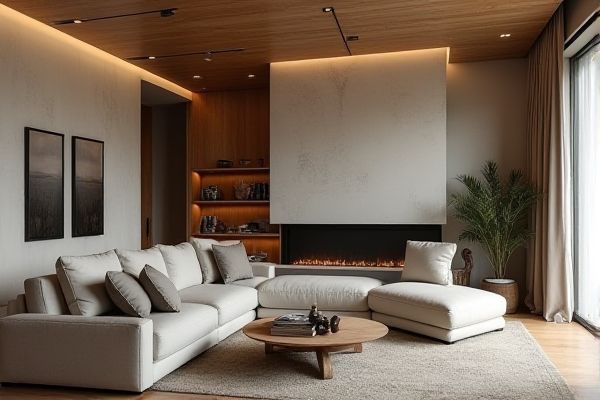
Mono stringer systems offer simpler installation and reduced costs by using a single power string, while dual stringer setups provide enhanced system reliability and flexible performance monitoring by operating two independent power strings. Discover how choosing between mono stringer and dual stringer configurations can impact Your solar energy system's efficiency and long-term savings by reading the full article.
Table of Comparison
| Feature | Mono Stringer | Dual Stringer |
|---|---|---|
| Definition | Single central beam supporting the decking | Two parallel beams supporting the decking |
| Load Distribution | Concentrated load on one beam | Even load distribution across two beams |
| Strength | Lower overall structural strength | Higher structural strength and stability |
| Weight | Lighter construction | Heavier due to additional beam |
| Cost | Generally more cost-effective | Higher cost from extra materials |
| Application | Suitable for light to moderate loads | Ideal for heavy loads and long spans |
| Maintenance | Fewer parts to maintain | More complex maintenance due to additional components |
Introduction to Mono Stringer and Dual Stringer Staircases
Mono stringer staircases feature a single central support beam, offering a sleek, minimalist design that maximizes open space and enhances modern architectural aesthetics. Dual stringer staircases utilize two side stringers for structural support, providing increased stability and the ability to accommodate heavier loads or wider treads. Both designs are popular in residential and commercial applications, with mono stringers emphasizing visual lightness and dual stringers prioritizing robustness and traditional appeal.
Design Aesthetics: Mono vs. Dual Stringers
Mono stringer surfboards feature a single central stringer that enhances clean lines and minimalist design aesthetics, appealing to surfers who prefer a classic, streamlined look. Dual stringer boards incorporate two narrow wooden strips on either side of the center, adding visual complexity and a sense of structural balance without overwhelming the board's overall style. Your choice between mono and dual stringers can subtly influence the board's visual impact while complementing your personal taste in surfboard design.
Structural Integrity and Load Distribution
Dual stringer configurations enhance structural integrity by distributing loads evenly across two support beams, reducing stress concentrations and increasing overall stability. Mono stringer systems concentrate loads on a single beam, which can lead to higher stress and potential fatigue over time, especially under heavy or dynamic loads. Engineering analyses show dual stringers improve load distribution efficiency, minimizing deflection and extending the lifespan of structural components in bridges, stairs, and rail systems.
Space Efficiency Comparison
Dual stringer systems offer improved space efficiency compared to mono stringers by distributing weight more evenly, allowing for thinner, longer spans with reduced support structures. Mono stringers typically require bulkier components or additional supports, occupying more space and limiting design flexibility. Optimizing beam arrangement in dual stringer configurations maximizes usable floor or deck area while maintaining structural integrity.
Installation Process: Mono vs. Dual Stringers
Mono stringer installation involves securing a single central support beam, simplifying alignment and reducing labor time, making it ideal for lightweight or narrower boards. Dual stringer setups require precise placement of two parallel supports, offering enhanced strength and stability for heavier or wider structures but increasing complexity and installation duration. Understanding the balance between structural needs and installation efficiency is crucial when choosing between mono and dual stringer configurations.
Cost Analysis: Upfront and Long-Term Maintenance
Mono stringer systems typically have lower upfront costs due to simpler design and fewer materials required, making them attractive for budget-conscious projects. Dual stringer configurations incur higher initial expenses but often offer enhanced durability and load distribution, potentially reducing long-term maintenance and repair costs. Evaluating the total cost of ownership reveals that dual stringers may provide better value by minimizing downtime and extending structural lifespan despite the higher initial investment.
Safety Considerations for Each Stringer Type
Mono stringers offer enhanced structural integrity by concentrating support along a single central beam, reducing the risk of uneven load distribution and potential accidents. Dual stringers provide increased stability with two parallel beams, allowing for better weight distribution and minimizing the chance of structural failure under heavy loads. Your choice between mono and dual stringers should prioritize the specific safety requirements of the application, considering load capacity and environmental factors.
Material Compatibility and Options
Mono stringers typically support a narrower range of materials, primarily accommodating standard hardwoods and softwoods, while dual stringers offer enhanced compatibility with various engineered and composite decking products. The dual stringer design provides better structural support, making it suitable for heavier or more flexible materials such as PVC, aluminum, or exotic hardwoods. If your project requires versatility in decking material choice, opting for dual stringers ensures greater durability and performance across diverse options.
Ideal Applications for Mono and Dual Stringers
Mono stringers are ideal for lightweight kayaks and canoes, as they offer simpler construction and ease of maintenance, making them perfect for recreational paddling or fishing activities where moderate stability suffices. Dual stringers enhance stiffness and load distribution, providing superior performance for heavier loads or rough-water conditions, which suits expedition kayaks and high-performance racing vessels. Your choice between mono and dual stringers should align with the kayak's intended use and the balance between weight, strength, and maneuverability required.
Choosing the Right Stringer System for Your Project
Choosing between a mono stringer and a dual stringer system hinges on your project's structural needs and aesthetic preferences. A mono stringer, offering a sleek, minimalist look, supports stairs with a single central beam, optimizing space and enhancing modern design. Dual stringers provide increased stability and traditional appeal by supporting stairs on both sides, ideal for heavier loads or classic architectural styles.
 homyna.com
homyna.com